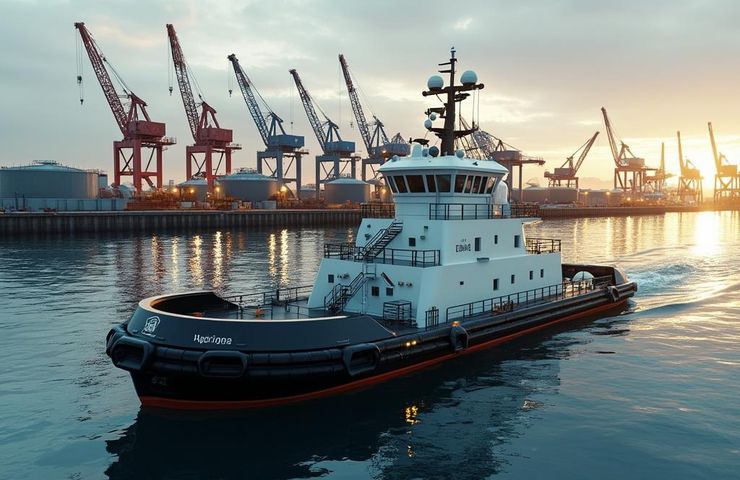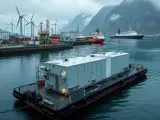
Hydrogen Tugboats Set to Scale: CMB.TECH Launches Dual-Fuel Build Program
June 26, 2025Dual-Fuel Hydrogen Tugs Poised to Reshape Port Decarbonization
CMB.TECH, the Belgian maritime innovator known for launching the world’s first hydrogen-powered tugboat, is gearing up for the next big step. They’re working with Damen Shipyards, Lloyd’s Register, and MAN Truck & Bus to design — and possibly build — up to eight ASD (Azimuth Stern Drive) dual-fuel tugboats that can run on both hydrogen and diesel. Construction is expected to kick off in 2025 at Damen’s shipyards in Vietnam, with deployment aimed at forward-thinking ports in Belgium, Northern Europe, and Australia.
Why This Matters
This isn’t your typical green tech demo. It’s a real move toward tackling industrial decarbonization in the maritime world — one of the hardest sectors to clean up. Right now, most tugboats run on diesel and contribute a ton to local port emissions. CMB.TECH is flipping that script by slipping hydrogen storage tanks under the deck and using a dual-fuel engine platform from MAN that allows the vessels to switch between hydrogen and diesel. That flexibility is key on the journey to full, zero-emission technology.
The Strategic Edge
What really sets this project apart is how serious they are about scale. These aren’t one-offs. Unlike the original Hydrotug 1, which was more of a showpiece built in Spain, the new models are built to be repeatable, standardized, and easy to manufacture. They’ll come in two versions — a 27m and a 33m model — one optimized for tight port navigation, the other built to handle rougher waters. That makes them versatile enough to work pretty much anywhere.
And let’s talk about that dual-fuel capability. It’s a clever workaround for one of the biggest challenges in rolling out hydrogen infrastructure: the lack of, well, infrastructure. These tugs give ports a cleaner option right now, without needing to wait years for the hydrogen supply chain to fully mature. It’s a plug-and-play solution with lower emissions from day one.
Hydrotug 1 Lessons Inform the Fleet
Since going into service in 2022 at the Port of Antwerp-Bruges, Hydrotug 1 has been a learning lab for the entire operation. Everything from crew training, to safety drills, to the ins and outs of hydrogen bunkering has been tested and refined. All those insights are being built directly into the next generation of tugs. Plus, Lloyd’s Register is heading up the safety reviews, which means the new tugs will stick to top-tier standards like IMO Tier III and EU Stage V.
Technology Snapshot
- Dual-fuel hydrogen-diesel engines: These MAN engines can run on a mix of hydrogen and diesel, helping maintain performance without sacrificing sustainability.
- Compressed hydrogen storage (below deck): Safe, space-saving tanks tucked below the surface to maximize efficiency.
- SCR and particulate filters: Systems that slash emissions when operating on diesel, keeping things cleaner in the transition period.
Ripple Effect for Hydrogen Maritime Adoption
This really could be the inflection point. The move from flashy pilot projects to actual, scalable vessels is a big deal. It provides proof of concept not just for shipbuilders, but for everyone from hydrogen infrastructure providers to port authorities. This is real-world data in motion — a blueprint others can follow.
If these tugs prove themselves in daily operations, they could become the new baseline for hydrogen-powered port vessels throughout Europe, Australia, and beyond. And with other projects already in the pipeline — like CMB.TECH’s upcoming hydrogen-powered utility vessels — momentum for zero-emission technology at sea is picking up fast.
The Road Ahead
We don’t know yet who the end customers will be or exactly where these vessels will drop anchor first, but we do know this: deliveries are expected to start mid-2025. That’s just around the corner.
“This is the shift we’ve been waiting for in port decarbonization — practical, proven, and ready to go,” a maritime expert might say. And honestly? They’d be spot on.
As hydrogen production becomes more affordable and global hydrogen storage and fueling systems come online, these dual-fuel tugboats could be leading the fleet in a cleaner, smarter port ecosystem.



 With over 15 years of reporting hydrogen news, we are your premier source for the latest updates and insights in hydrogen and renewable energy.
With over 15 years of reporting hydrogen news, we are your premier source for the latest updates and insights in hydrogen and renewable energy.